Limnology: Lake Ecology
Flathead Lake: Water Quality and Limnology
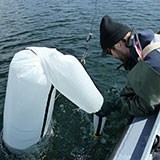
Flathead Lake is the largest natural freshwater lake in the western US, and one of the cleanest large lakes in the world. However, its world renowned water clarity and ecological health continue to be threatened by human-caused increases in nutrients and sediments, as well as the potential arrival of new Aquatic Invasive Species.
The FLBS record of research began in 1899, the year FLBS was founded, when Dr. Morton J. Elrod initiated the first scientific investigations of the lake. FLBS has remained the “Sentinel of Flathead Lake” ever since.
In 1977, in response to threats of large-scale coal mining in the North Fork Flathead River in British Columbia, Canada, FLBS instituted a scientifically rigorous water quality research and monitoring program and now has one of the best long-term continuous datasets in the world for a large lake and river system.
Our regular (roughly monthly) monitoring program provides a clear, consistent record of physical, chemical and biological lake characteristics and changes over time, and reveals threats before they become problems. Our scientific data, especially pertaining to nutrients, have been used by state and federal agencies in the development of water quality standards via the Clean Water Act’s Total Maximum Daily Load (TMDL) process.
Our research continues to address cutting edge questions about the ecological conditions of the lake. For example in 2012, FLBS researchers installed a network of telemetered environmental sensors (weather and water quality) to enhance the resolution of knowledge of lake conditions. Currently FLBS scientists are utilizing this data in concert with the long-term dataset to drive a lake model that will help predict future conditions in the lake related to changes such as increasing temperature, the arrival of new species and the removal of existing ones (e.g., lake trout).
FLBS research and expertise regularly help managers and politicians make informed decisions that have resulted in significant water quality conservation successes, including a ban on Phosphorus-containing detergents, the upgrade of watershed sewage treatment systems, and the prevention of mining in the North Fork Flathead River.
Maintaining the high quality of water that many people in the Flathead Valley take for granted does not come without effort. If you would like to help with efforts to maintain Flathead water quality now and for future generations, visit the FLBS charitable giving page
- Elrod, M. J. 1901. Limnological investigations at Flathead Lake, Montana and vicinity, July 1899. Transactions of the American Microscopical Society 22:68–80
- Elrod, M. J. 1929. The fishes of Flathead Lake. Montana Fish and Game, Helena, 11.
- Stanford, J. A. and D. S. Potter. 1976. Limnology of the Flathead Lake-River Ecosystem, Montana: A perspective. Ecological Society of America, Eastern Washington State College Press, Cheney. 241–252 pp.
- Ellis, B. K. and J. A. Stanford. 1988. Phosphorus bioavailability of fluvial sediments determined by algal assays. Hydrobiologia 160:9–18.
- Spencer, C. N. and B. K. Ellis. 1990. Co-limitation by phosphorus and nitrogen, and effects of zooplankton mortality, on phytoplankton in Flathead Lake, Montana, USA. Verh. Internat. Verein. Limnol. 24:206–209.
- Spencer, C. N. and B. K. Ellis. 1998. Role of nutrients and zooplankton in regulation of phytoplankton in Flathead Lake (Montana, USA), a large oligotrophic lake. Freshwater Biology 39(4):755–763.
- Ellis, B. K., J. A. Stanford, D. Goodman, C. P. Stafford, D. L. Gustafson, D. A. Beauchamp, D. W. Chess, J. A. Craft, M. A. Deleray and B. S. Hansen. 2011. Long-term effects of a trophic cascade in a large lake ecosystem. Proceedings of the National Academy of Sciences USA 108(3):1070–1075.
Flathead Lake Trophic Cascade
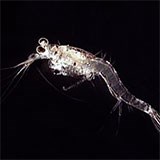 Introduced species have altered Flathead Lake’s biological community dramatically over the last 100+ years. Of particular note was the introduction of Mysis diluviana. This freshwater shrimp’s introduction resulted in dramatic food web changes that were documented by FLBS scientists.
Introduced species have altered Flathead Lake’s biological community dramatically over the last 100+ years. Of particular note was the introduction of Mysis diluviana. This freshwater shrimp’s introduction resulted in dramatic food web changes that were documented by FLBS scientists.
Introduced widely in the 1960s and 1970s throughout Western North America as a food source for salmon and trout, in Flathead Lake the Mysis shrimp voraciously consumed zooplankton, the food of the kokanee salmon they were introduced to help. This unexpected effect resulted in the collapse of the kokanee population, which eliminated a reliable food source for hundreds of bald eagles and bears that annually migrated to the kokanee spawning grounds in the Flathead River system.
At the same time, populations of nonnative lake trout and lake whitefish, which were themselves an introduced species, exploded with Mysis shrimp as a food source. With the increase in both Mysis shrimp and lake trout, native bull and cutthroat trout populations have dramatically declined, and Flathead Lake’s fish community is now dominated by nonnative species. Additionally, as Mysis shrimp consume native zooplankton which eat algae, the amount of algae in Flathead Lake has increased.
Therefore, the introduction of Mysis shrimp not only influenced the biological community of Flathead Lake but also directly affected the lake’s water quality.
FLBS researchers were among the first to empirically document this Trophic Cascade in a lake ecosystem, and they continue to track the ongoing ecological effects.
- Spencer, C. N., B. R. McClelland and J. A. Stanford. 1991. Shrimp stocking, salmon collapse and eagle displacement: Cascading interactions in the food web of a large aquatic ecosystem. BioScience 41(1):14–21.
- Stafford, C. P., J. A. Stanford, F. R. Hauer and E. B. Brothers. 2002. Changes in lake trout growth associated with mysis relicta establishment: A retrospective analysis using otoliths. Transactions of the American Fisheries Society 131(5):994–1003.
- Ellis, B. K., J. A. Stanford, D. Goodman, C. P. Stafford, D. L. Gustafson, D. A. Beauchamp, D. W. Chess, J. A. Craft, M. A. Deleray and B. S. Hansen. 2011. Long-term effects of a trophic cascade in a large lake ecosystem. Proceedings of the National Academy of Sciences USA 108(3):1070–1075. Read now (link on old site)
Lake Ecology
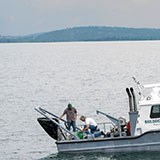 Over the years, FLBS researchers have conducted a wide array of studies on lakes, examining the influence of a variety of factors including: physical (eg, temperature, depth, habitat), chemical (eg, nutrients, pollutants, sediments) and biological (eg, competition, predation, introduced species). In addition to our flagship Flathead Lake Research and Monitoring Program, FLBS scientists and students have:
Over the years, FLBS researchers have conducted a wide array of studies on lakes, examining the influence of a variety of factors including: physical (eg, temperature, depth, habitat), chemical (eg, nutrients, pollutants, sediments) and biological (eg, competition, predation, introduced species). In addition to our flagship Flathead Lake Research and Monitoring Program, FLBS scientists and students have:
- Conducted surveys of previously unstudied lakes in the Flathead Watershed, including lakes in the Bob Marshall Wilderness complex and the first aquatic science from Glacier National Park.
- Revisited and repeated historic investigations of remote lakes.
- Overseen and synthesized volunteer lake monitoring efforts of more than 40 lakes in the Flathead Watershed.
- Conducted ecological research and monitoring on lakes including Swan and Whitefish, assisting state and federal management agencies with development of water quality standards through the Clean Water Act’s Total Maximum Daily Load (TMDL) process.
- Coordinated comparative analysis of large lakes in the Northern Rocky Mountains, such as Flathead, Pend D’Oreille, Coeur D’Alene and Yellowstone.
- Examined the role of lake ecology and productivity in foodwebs and fish production.
- Elrod, M. J. 1910. The lakes of Glacier National Park, I Avalanche Lake. Transactions of the American Microscopical Society 29(2):110–117.
- Elrod, M. J. 1912. The lakes of Glacier National Park, II Lake Louise. Transactions of the American Microscopical Society 31(2):11–16.
- Stanford, J. A. and G. W. Prescott. 1988. Limnological features of a remote alpine lake in Montana, including a new species of Cladophora (Chlorophyta). Journal of the North American Benthological Society 7(2):140–151.
- Wicklum, D. 1999. Variation in horizontal zooplankton abundance in mountain lakes: shore avoidance or fish predation? Journal of Plankton Research 21(10):1957–1975.
- Ellis, B. K., J. A. Stanford, J. A. Craft, D. W. Chess, F. R. Hauer and D. C. Whited. 2003. Plankton communities of alpine and subalpine lakes in Glacier National Park, Montana, USA, 1984 - 1990. Verh. Internat. Verein. Limnol. 28(3):1542–1550.
- Ellis, B. K. and J. A. Craft. 2008. Trophic status and trends in water quality for Volunteer Monitoring Program lakes in northwestern Montana, 1993–2007. Polson, Prepared for Flathead Basin Commission, Kalispell, Montana by Flathead Lake Biological Station, The University of Montana.
- Hill, A. C., J. A. Stanford and P. R. Leavitt. 2009. Recent sedimentary legacy of sockeye salmon (Oncorhynchus nerka) and climate change in an ultraoligotrophic, glacially-turbid British Columbia nursery lake. Canadian Journal of Fisheries and Aquatic Sciences 66(7):1141–1152.
Physical Limnology
 FLBS conducts research examining the physical characteristics and processes of freshwater ecosystems. Physical conditions are the template on which biological organisms and processes are overlain, and therefore they can significantly influence ecology. Since resources are not evenly distributed throughout lakes and rivers, physical drivers such as water currents are examined to determine how they deliver nutrients and other needed materials. FLBS scientists and students have examined water conditions (eg, temperature, depth) and water movement (eg, currents and waves); as well as sediment erosion, transport and deposition, and the creation of beaches to curb shoreline erosion. Investigations into the response of aquatic organisms to the sound of rivers has even spawned a collaborative performance with UM’s School of Theatre and Dance.
FLBS conducts research examining the physical characteristics and processes of freshwater ecosystems. Physical conditions are the template on which biological organisms and processes are overlain, and therefore they can significantly influence ecology. Since resources are not evenly distributed throughout lakes and rivers, physical drivers such as water currents are examined to determine how they deliver nutrients and other needed materials. FLBS scientists and students have examined water conditions (eg, temperature, depth) and water movement (eg, currents and waves); as well as sediment erosion, transport and deposition, and the creation of beaches to curb shoreline erosion. Investigations into the response of aquatic organisms to the sound of rivers has even spawned a collaborative performance with UM’s School of Theatre and Dance.
- Lorang, M. S., J. A. Stanford, F. R. Hauer and J. H. Jourdonnais. 1993. Dissipative and reflective beaches in a large lake and the physical effects of lake level regulation. Ocean and Coastal Management 19(3):263–287.
- Lorang, M. S. and J. A. Stanford. 1993. Variability of shoreline erosion and accretion within a beach compartment of Flathead Lake, Montana. Limnology and Oceanography 38(8):1783–1795.
- Lorang, M. S. 2011. A wave-competence approach to distinguish between boulder and megaclast deposits due to storm waves versus tsunamis. Marine Geology 283:90–97.
- Tonolla, D., M. S. Lorang, K. Heutschi, C. C. Gotschalk and K. Tockner. 2011. Characterization of spatial heterogeneity in underwater soundscapes at the river segment scale Limnology and Oceanography 56(6):2319–2333.
- Lorang, M. S. and D. Tonolla. 2014. Combining active and passive hydroacoustic techniques during flood events for rapid spatial mapping of bedload transport patterns in gravel-bed rivers. Fundamental and Applied Limnology 184(3):231246.
- Kirillin, G., M. S. Lorang, T. C. Lippmann, C. C. Gotschalk and S. Schimmelpfennig. 2014. Surface seiches in Flathead Lake. Hydrology and Earth System Sciences 11(12):13541–13570.
- Nichols, C. and M. Lorang. 2014. Sound of Rivers: Stone Drum, Translating limnology into multimedia IN: Proceedings of Korean Electro-Acoustic Music Society's 2014 Annual Conference (KEAMSAC2014), Seoul Korea, 8–9 October 2014.
Limnology: Stream & River Ecology
Floodplain Biocomplexity : Shifting Habitat Mosaic
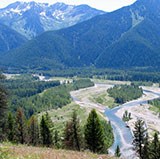 River flood plains are hot spots of biodiversity and productivity due to dynamic interactions between water, sediments, vegetation, and other organisms. Connectivity between surface and ground waters plays an important role in floodplain ecology and habitat diversity, particularly through the exchange of water and materials between the river and the alluvial aquifer that lies just under the surface. This extensive surface and groundwater connectivity also sustains water quantity and quality. Due to human development, floodplains are one of the most endangered ecosystems in the world.
River flood plains are hot spots of biodiversity and productivity due to dynamic interactions between water, sediments, vegetation, and other organisms. Connectivity between surface and ground waters plays an important role in floodplain ecology and habitat diversity, particularly through the exchange of water and materials between the river and the alluvial aquifer that lies just under the surface. This extensive surface and groundwater connectivity also sustains water quantity and quality. Due to human development, floodplains are one of the most endangered ecosystems in the world.
For decades, FLBS researchers have been studying these processes and how they influence organisms at the Nyack Floodplain Research Natural Area on the Middle Fork Flathead River, located between Glacier National Park and the Great Bear Wilderness. This research has demonstrated the vital importance of surface and ground water exchange and has fundamentally molded contemporary river science, management, and conservation.
Currently, FLBS PhD student Amanda DelVecchia is studying how naturally occurring methane gas may subsidize productivity on the flood plain. Amanda is characterizing microbial and invertebrate communities in relation to the environmental gradients of the alluvial aquifer to better understand utilization of methane and organic matter. Her work aims to understand how organisms use, cleanse, and enrich water as it flows through the aquifer, information that is needed to sustain the ecological integrity of rivers around the world. Large stoneflies are iconic players in this story as analyses show that they feed on microbes that use methane as an energy source.
Read more about the Biocomplexity project (link on old site)
- Tockner, K. and J. A. Stanford. 2002. Riverine flood plains: present state and future trends. Environmental Conservation 29(3):308–330.
- Harner, M. J. and J. A. Stanford. 2003. Differences in cottonwood growth between a losing and a gaining reach of an alluvial flood plain. Ecology 84(6):1453–1458.
- Poole, G. C., J. A. Stanford, S. W. Running, C. A. Frissell, W. W. Woessner and B. K. Ellis. 2004. A patch hierarchy approach to modeling surface and subsurface hydrology in complex flood-plain environments. Earth Surface Processes and Landforms 29(10):1259–1284.
- Stanford, J. A., M. S. Lorang and F. R. Hauer. 2005. Plenary lecture: the shifting habitat mosaic of river ecosystems. Verhandlungen Internationale Vereinigung für Theoretische und Angewandte Limnologie 29(1):123–136.
- Whited, D. C., M. S. Lorang, M. J. Harner, F. R. Hauer, J. S. Kimball and J. A. Stanford. 2007. Climate, hydrologic disturbance, and succession: drivers of floodplain pattern. Ecology 88(4):940–953.
- Mouw, J. E. B., J. A. Stanford and P. B. Alaback. 2009. Influences of flooding and hyporheic exchange on floodplain plant richness and productivity. River Research and Applications 25(8):929–945.
- Morris, M. R., B. O. Brouwer, J. K. Caves, M. J. Harner and J. A. Stanford. 2010. Successional changes in soil and hyporheic nitrogen fertility on an alluvial flood plain: implications for riparian vegetation. Aquatic Sciences 72: 519–532.
- Tockner, K., M. S. Lorang and J. A. Stanford. 2010. River floodplains as model ecosystems to test general hydrogeomorphic and ecological concepts. River Research and Applications 26(1): 76–86.
- Helton, A. M., G. C. Poole, R. A. Payn, C. Izurieta and J. A. Stanford. 2014. Relative influences of the river channel, floodplain surface, and alluvial aquifer on simulated hydrologic residence time in a montane river floodplain. Geomorphology 205:17–26.
Hyporheic Corridor Concept of River Ecosystems
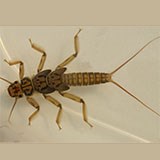 A wide variety of previously unknown biota, including stoneflies and other large-bodied organisms, exist within alluvial aquifers of the expansive flood plains of the Flathead and other gravel-bed rivers. This amazing discovery led to the “hyporheic corridor concept” of river ecosystems, which first formalized the fundamental importance of water and materials interchange between the river channel and near-surface groundwater. Organisms living in the groundwater utilize organic matter form the river and floodplain as a food source, thereby filtering, or cleansing the river water as it moves through the porous bedsediments.
A wide variety of previously unknown biota, including stoneflies and other large-bodied organisms, exist within alluvial aquifers of the expansive flood plains of the Flathead and other gravel-bed rivers. This amazing discovery led to the “hyporheic corridor concept” of river ecosystems, which first formalized the fundamental importance of water and materials interchange between the river channel and near-surface groundwater. Organisms living in the groundwater utilize organic matter form the river and floodplain as a food source, thereby filtering, or cleansing the river water as it moves through the porous bedsediments.
- Stanford, J. A. and J. V. Ward. 1988. The hyporheic habitat of river ecosystems. Nature 335(6185):64–66.
- Stanford, J. A. and J. V. Ward. 1993. An ecosystem perspective of alluvial rivers: connectivity and the hyporheic corridor. Journal of the North American Benthological Society 12(1):48–60.
- Stanford, J. A., J. V. Ward and B. K. Ellis. 1994. Ecology of the alluvial aquifers of the Flathead River, Montana, pp. 367–390. IN: Gibert, J., D. L. Danielopol, J. A. Stanford (ed.), Groundwater Ecology. Academic Press, Inc., San Diego.
- Boulton, A. J., T. Datry, T. Kasahara, M. Mutz and J. A. Stanford. 2010. Ecology and management of the hyporheic zone: stream–groundwater interactions of running waters and their floodplains. Journal of North American Benthological Society 29(1):20–40.
Ecological Effects of Dams: Regulated Rivers and the Serial Discontinuity Concept
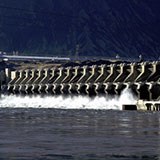 River ecosystems are altered dramatically by the presence of dams and reservoirs. Reservoirs directly convert river habitat into lakes, environments for which most river organisms are not well suited. Dams interrupt the continuity of conditions and transportation of materials in streams and rivers as flow moves downstream.
River ecosystems are altered dramatically by the presence of dams and reservoirs. Reservoirs directly convert river habitat into lakes, environments for which most river organisms are not well suited. Dams interrupt the continuity of conditions and transportation of materials in streams and rivers as flow moves downstream.
After the major dam building era in the US, 1940s–1960s, FLBS researchers were among the first to scientifically examine the ecological effects of dams, pioneering the field, writing the first text book, and founding the first journal about Regulated Rivers.
Findings have shown that rivers are changed but can reset or recover from the deleterious impacts of dams in relation to mode of dam operations and distance downstream from the dam. This discovery was formalized into the “Serial Discontinuity Concept” of river ecosystems, which predicts the ecological effects of dam operations and allows water, temperature, and material fluxes to be normalized, thereby ameliorating impacts of river regulation on biota, sediment transport, habitat characteristics, riparian vegetation, and other important attributes of rivers.
FLBS research has helped shape today’s dialogue balancing the ecological costs of dams with their benefits to society. This is particularly important as many dams in the US are currently undergoing re-licensing, a process that determines future dam operations for the next 20-50 years. This process now requires the consideration of ecological effects, which at times has even resulted in the recommendation of dam removal.
- Ward, J. V. and J. A. Stanford. 1979. The Ecology of Regulated Streams. Plenum Press, New York.
- Ward, J. V. and J. A. Stanford. 1983. The serial discontinuity concept of lotic ecosystems, pp. 29–42. IN: Fontaine, T. D. I. and S. M. Bartell (eds.), Dynamics of Lotic Ecosystems. Ann Arbor Science Publishers, Ann Arbor.
- Stanford, J. A. and J. V. Ward. 1983. The effects of mainstream dams on physicochemistry of the Gunnison River, Colorado, pp. 43–56. IN: Adams, V. D. and V. A. Lamarra (eds.), Aquatic Resources Management of the Colorado River Ecosystem. Ann Arbor Sci. Publ., Ann Arbor.
- Stanford, J. A., F. R. Hauer and J. V. Ward. 1988. Serial discontinuity in a large river system. Verh. Internat. Verein. Limnol. 23:1114–1118.
- Stanford, J. A. and F. R. Hauer. 1992. Mitigating the impacts of stream and lake regulation in the Flathead River Catchment, Montana, USA: An ecosystem perspective. Aquatic Conservation: Marine and Freshwater Ecosystems 2(1):35–63.
- Ward, J. V. and J. A. Stanford. 1995. The serial discontinuity concept: extending the model to floodplain rivers. Regulated Rivers: Research and Management 10(2–4):159–168.
- Hauer, F. R. and M. S. Lorang. 2004. River regulation, decline of ecological resources, and potential for restoration in a semi-arid lands river in the western USA. Aquatic Sciences 66:1–14.
- Lorang, M. S. and G. Aggett. 2005. Potential sedimentation impacts related to dam removal: Icicle Creek, Washington, USA. Geomorphology 71:182–201.
- Lorang, M. S., F. R. Hauer, D. C. Whited and P. L. Matson. 2013. Assessing flow releases from a dam to maximize renaturalization of a regulated gravel-bed river using airborne remote sensing imagery. Reviews in Engineering Geology 21:117–132.
Life History Energy Balance of Organisms
 Most aquatic organisms are "cold blooded" (ectotherms), meaning that their body temperature, metabolism, and ecological activity are determined by the temperature of their surrounding environment. Therefore water temperature is one of the most important determinants of occurrence, growth, reproduction, survival, and all around success for aquatic organisms (e.g. insects, frogs, and fish).
Most aquatic organisms are "cold blooded" (ectotherms), meaning that their body temperature, metabolism, and ecological activity are determined by the temperature of their surrounding environment. Therefore water temperature is one of the most important determinants of occurrence, growth, reproduction, survival, and all around success for aquatic organisms (e.g. insects, frogs, and fish).
FLBS research has shown that water temperature drives biological patterns observed on the landscape. For example, aquatic insects and other organisms are distributed predictably along stream corridors from headwaters to piedmont valleys in relation to temperature patterns. On floodplains, thermal characteristics of different habitat types throughout the year determine which aquatic organisms are able to thrive (or just survive) in which locations during different life history stages.
These discoveries about life history energy balance of organisms in montane environments have important ramifications for predicting the consequences of climate change.
- Ward, J. V. and J. A. Stanford. 1982. Thermal responses in the evolutionary ecology of aquatic insects. Annual Review of Entomology 27:97–117.
- Hall, C. A. S., J. A. Stanford and F. R. Hauer. 1992. The distribution and abundance of organisms as a consequence of energy balances along multiple environmental gradients. Oikos 65(3):377–390.
- Lowe, W. H. and F. R. Hauer. 1999. Ecology of two large, net-spinning caddisfly species in a mountain stream: distribution, abundance and metabolic response to a thermal gradient. Canadian Journal of Zoology 77:1637–1644
- Wu, H., J. S. Kimball, M. M. Elsner, N. Mantua, R. F. Adler and J. A. Stanford. 2012. Projected climate change impacts on the hydrology and temperature of Pacific Northwest rivers. Water Resources Research 48:W11530.
- Muhlfeld, C. C., R. P. Kovach, L. A. Jones, R. Al-Chokhachy, M. C. Boyer, R. F. Leary, W. H. Lowe, G. Luikart and F. W. Allendorf. 2014. Invasive hybridization in a threatened species is accelerated by climate change. Nature Climate Change 4:620–624.
- Giersch, J. J., S. Jordan, G. Luikart, L. A. Jones, F. R. Hauer and C. C. Muhlfeld. 2015. Climate-induced range contraction of a rare alpine aquatic invertebrate. Freshwater Science 34(1):000–000.
- Stanford, J. A., M. L. Anderson, B. L. Reid, S. D. Chilcote, and T. S. Bansak. In press. Thermal diversity and the phenology of floodplain aquatic biota. In: D. Gilvear, M. Greenwood, M. Thoms, and P. Wood, editors. River Science: Research and Applications for the 21st Century. Wiley.
Conservation Ecology & Genetics
Conservation Genetics and Non-Native Species
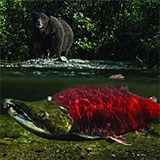 New tools in quantitative genetics allow FLBS researchers to gain a more detailed understanding of the relationships between native and non-native species and to explore their interactions within the context of climate change and other environmental influences.
New tools in quantitative genetics allow FLBS researchers to gain a more detailed understanding of the relationships between native and non-native species and to explore their interactions within the context of climate change and other environmental influences.
More information is available on the FLBS Conservation Genetics page.
- Geffen, E., G. Luikart, and R.S. Waples. 2006. Impacts of modern molecular techniques on conservation biology. Chapter 4 In: Key Topics in Conservation Biology, Eds: D.W. Macdonald and K. Service, Blackwell Publishing.
- Schwartz, M.K., G. Luikart, and R.S. Waples. 2007. Genetic monitoring as a promising tool for conservation and management. Trends in Ecology and Evolution, 22:25-33.
- Beja-Pereira, A., B.J. Bricker, S. Chen, *C. Almendra, P.J. White, and G. Luikart. 2009. DNA genotyping suggests recent brucellosis outbreaks near Yellowstone National Park originate from elk. Journal of Wildlife Diseases, 45:1174-1177.
- Archie, E.A., G. Luikart, and V. Ezenwa. 2009. Infecting epidemiology with genetics: A new frontier in disease ecology. Trends in Ecology and Evolution, 24:21-30.
- Allendorf, F.W., P. Hohenlohe, and G. Luikart. 2010. Genomics and the future of conservation. Invited Review, Nature Reviews Genetics, 11:697-709.
- Allendorf, F. W., G. Luikart and S. N. Aitken. 2013. Conservation and the Genetics of Populations, 2nd edition. Wiley-Blackwell, Chichester
- Andrews, K.R., and G. Luikart. 2014. Recent novel approaches for population genomics data analysis. Molecular Ecology, 23:1661-7. doi: 10.1111/mec.12686.
Salmon Ecology
Landscape Ecology of Pacific Salmon
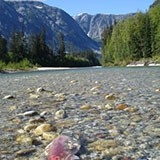 FLBS in cooperation with other organizations documented salmonid biodiversity and productivity of a suite of pristine Pacific salmon river ecosystems observatories. The research focused on salmonid habitat requirements that appeared to vary with life history stage and population structure. We believed that productivity of habitat is controlled by non-linear biophysical processes that create and maintain a dynamic or constantly Shifting Habitat Mosaic (SHM). Our research also addressed how salmon rivers and their stocks respond to climate change. Runoff and temperature patterns are primary determinants of physical habitat in rivers and therefore critically influence salmon productivity. Since both variables may be changed significantly by climate warming, better resolution of climate effects was needed to produce robust conservation strategies for salmon and salmon related biodiversity. Human activities tend to reduce or dampen the variable nature of rivers in ways that should be predictable and, therefore, correctable given a robust understanding and modeling of salmon productivity and population dynamics in the context of the SHM concept.
FLBS in cooperation with other organizations documented salmonid biodiversity and productivity of a suite of pristine Pacific salmon river ecosystems observatories. The research focused on salmonid habitat requirements that appeared to vary with life history stage and population structure. We believed that productivity of habitat is controlled by non-linear biophysical processes that create and maintain a dynamic or constantly Shifting Habitat Mosaic (SHM). Our research also addressed how salmon rivers and their stocks respond to climate change. Runoff and temperature patterns are primary determinants of physical habitat in rivers and therefore critically influence salmon productivity. Since both variables may be changed significantly by climate warming, better resolution of climate effects was needed to produce robust conservation strategies for salmon and salmon related biodiversity. Human activities tend to reduce or dampen the variable nature of rivers in ways that should be predictable and, therefore, correctable given a robust understanding and modeling of salmon productivity and population dynamics in the context of the SHM concept.
Read more about the SaRON project (link on old site)
- Savvaitova, K. A., K. V. Kuzishchin, M. A. Gruzdeva, D. S. Pavlov, J. A. Stanford and B. K. Ellis. 2003. Long-term and short-term variation in the population structure of Kamchatka steelhead Parasalmo mykiss from rivers of western Kamchatka. Journal of Ichthyology 43(9):757–768.
- McPhee, M. V., F. Utter, J. A. Stanford, K. V. Kuzishchin, K. A. Savvaitova, D. S. Pavlov and F. W. Allendorf. 2007. Population structure and partial anadromy in Oncorhynchus mykiss from Kamchatka: relevance for conservation strategies around the Pacific Rim. Ecology of Freshwater Fishes 16(4):539–547.
- McPhee, M. V., T. H. Tappenbeck, D. C. Whited and J. A. Stanford. 2009. Genetic diversity and population structure in the Kuskokwim River drainage support the 'recurrent evolution' hypothesis for sockeye salmon life histories. Transactions of the American Fisheries Society (138):1481–1489.
- Pavlov, D. S., K. A. Savvaitova, K. V. Kuzishchin, M. A. Gruzdeva and J. A. Stanford. 2009. The Status and Monitoring of the Salmonid Biodiversity and Their Environment on Kamchatka (on the Territory of the "River Kol" Protected Area). KMK Scientific Press, Moscow.
- Hill, A. C., T. S. Bansak, B. K. Ellis and J. A. Stanford. 2010. Merits and limits of ecosystem protection for conserving wild salmon in a northern coastal British Columbia river. Ecology and Society 15(2):20 [online] URL: http://www.ecologyandsociety.org/vol15/iss2/art20/.
- Eberle, L. C. and J. A. Stanford. 2010. Importance and seasonal availability of terrestrial invertebrates as prey for juvenile salmonids in floodplain spring brooks of the Kol River (Kamchatka, Russian Federation). River Research and Applications 26:682–694.
- Morris, M. R. and J. A. Stanford. 2011. Floodplain succession and soil nitrogen accumulation on a salmon river in southwestern Kamchatka. Ecological Monographs 81(1):43–61.
- Price, M. H. H., A. G. J. Rosenberger, G. G. Taylor and J. A. Stanford. 2014. Comment: Population Structure and Run Timing of Sockeye Salmon in the Skeena River, British Columbia. North American Journal of Fisheries Management 34(6):1167–1170.
- McPhee, M. V., D. C. Whited, K. V. Kuzishchin and J. A. Stanford. 2014. The effects of riverine physical complexity on anadromy and genetic diversity in steelhead or rainbow trout Oncorhynchus mykiss around the Pacific Rim. Journal of Fish Biology 85(1):132–150.
Climate Change and Salmon Conservation
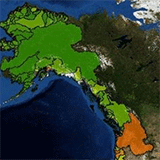 A presidential task force recently released a report requesting all federal agencies to consider climate-related risks and vulnerabilities as part of their policies and practices. However, climate change is seldom considered in salmonid conservation decision making, despite major declines in these ecologically and economically critical species. Protecting native salmonids and their riverscapes against the impacts of climate change demands better understanding of the interactive influences of environmental variation (especially water temperature and flow), habitat and anthropogenic stressors (e.g., landuse change), genetics/genomics, and population demographics (e.g., abundance). To meet this challenge, FLBS researchers continue work on applying a prototype decision support system (DSS) to aid in the decision-making process for conserving salmonids and their habitats under a changing climate.
A presidential task force recently released a report requesting all federal agencies to consider climate-related risks and vulnerabilities as part of their policies and practices. However, climate change is seldom considered in salmonid conservation decision making, despite major declines in these ecologically and economically critical species. Protecting native salmonids and their riverscapes against the impacts of climate change demands better understanding of the interactive influences of environmental variation (especially water temperature and flow), habitat and anthropogenic stressors (e.g., landuse change), genetics/genomics, and population demographics (e.g., abundance). To meet this challenge, FLBS researchers continue work on applying a prototype decision support system (DSS) to aid in the decision-making process for conserving salmonids and their habitats under a changing climate.
Read more about the Riverscape Analysis project
- Luck, M., N. Maumenee, D. Whited, J. Lucotch, S. Chilcote, M. Lorang, D. Goodman, K. McDonald, J. Kimball and J. Stanford. 2010. Remote sensing analysis of physical complexity of North Pacific Rim rivers to assist wild salmon conservation. Earth Surface Processes and Landforms 35(11):1330–1343.
- Wu, H., J. S. Kimball, N. Mantua and J. Stanford. 2011. Automated upscaling of river networks for macroscale hydrological modeling. Water Resources Research 47(3):W03517.
- Wu, H., J. S. Kimball, M. M. Elsner, N. Mantua, R. F. Adler and J. A. Stanford. 2012. Projected climate change impacts on the hydrology and temperature of Pacific Northwest rivers. Water Resources Research 48:W11530.
- Whited, D. C., J. S. Kimball, J. A. Lucotch, N. K. Maumenee, H. Wu, S. D. Chilcote and J. A. Stanford. 2012. A Riverscape Analysis Tool developed to assist wild salmon conservation across the North Pacific Rim. Fisheries 37(7):305–314.
- Whited, D. C., J. S. Kimball, M. S. Lorang and J. A. Stanford. 2013. Estimation of juvenile salmon habitat in Pacific Rim rivers using multiscalar remote sensing and geospatial analysis. River Research and Applications 29(2):135–148.
Brown Trout Ecology in the Rio Grande, Argentina
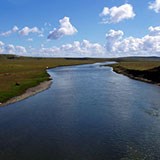 The Rio Grande brown trout study objective was to determine population parameters and factors controlling productivity of sea trout (sea-run brown trout) in the Rio Grande of Tierra del Fuego, Argentina. FLBS used the catch and release fly fishing operations of NWA and EMB as a basis for a mark and recapture study of the brown trout population within various study reaches of the river in association with other ecological measures encompassing the freshwater life cycle.
The Rio Grande brown trout study objective was to determine population parameters and factors controlling productivity of sea trout (sea-run brown trout) in the Rio Grande of Tierra del Fuego, Argentina. FLBS used the catch and release fly fishing operations of NWA and EMB as a basis for a mark and recapture study of the brown trout population within various study reaches of the river in association with other ecological measures encompassing the freshwater life cycle.
The project goal was to use the accumulated information as a basis for development of a strategy to sustain high-quality angling and ecotourism income in the Rio Grande and to use scientific results to better inform salmon and trout management worldwide.
- O'Neal, S. L. and J. A. Stanford. 2011. Partial migration in a robust brown trout population of a Patagonian river. Transactions of the American Fisheries Society 140(3):623–635.
Remote Sensing
Satellite and Aerial Imagery: Viewing Ecology from Above
 FLBS scientists have extensively utilized, and in fact pioneered, aspects of the use of aerial sensors and imagery (satellite and aircraft mounted) to examine ecological characteristics and patterns. At the watershed scale, FLBS has used multi-spectral imagery from both satellites and aircraft, in concert with on-the-ground Acoustic Doppler Profilers which can measure water depth, velocity and sediment movement, to develop techniques to classify, quantify, and map aquatic and riparian habitat. Additionally, by using Light Detection and Radar (LIDAR), FLBS researchers have constructed detailed topographic maps and information about river flood plains and lake shorelines.
FLBS scientists have extensively utilized, and in fact pioneered, aspects of the use of aerial sensors and imagery (satellite and aircraft mounted) to examine ecological characteristics and patterns. At the watershed scale, FLBS has used multi-spectral imagery from both satellites and aircraft, in concert with on-the-ground Acoustic Doppler Profilers which can measure water depth, velocity and sediment movement, to develop techniques to classify, quantify, and map aquatic and riparian habitat. Additionally, by using Light Detection and Radar (LIDAR), FLBS researchers have constructed detailed topographic maps and information about river flood plains and lake shorelines.
At the global scale, FLBS researchers have worked extensively with NASA’s satellite remote sensing programs (eg Landsat, MODIS and SMAP) and have been involved in the development and oversight of new sensors and analysis techniques. These technologies have resulted in extensive discoveries pertaining to the earth’s soil moisture, drought, freeze thaw cycles, and climate variability.
- Whited, D. C., J. A. Stanford and J. S. Kimball. 2003. Application of airborne multi-spectral digital imagery to characterize the riverine habitat. Verh. Internat. Verein. Limnol. 28(3):1373–1380.
- Lorang, M. S., D. C. Whited, F. R. Hauer, J. S. Kimball and J. A. Stanford. 2005. Using airborne multispectral imagery to evaluate geomorphic work across floodplains of gravel-bed rivers. Ecological Applications 15(4):1209–1222.
- Kimball, J. S. 2008. Earth observation of global change: the role of satellite remote sensing in monitoring the global environment. EOS 89(32):294.
- Zhang, K., J. S. Kimball, Q. Mub, L. A. Jones, S. J. Goetz and S. W. Running. 2009. Satellite based analysis of northern ET trends and associated changes in the regional water balance from 1983 to 2005. Journal of Hydrology 379:92–110.
- Kim, Y., J. S. Kimball, K. Zhang and K. C. McDonald. 2012. Satellite detection of increasing Northern Hemisphere non-frozen seasons from 1979 to 2008: Implications for regional vegetation growth. Remote Sensing of Environment 121:472–487.
- Jones, M. O., J. S. Kimball and L. A. Jones. 2013. Satellite microwave detection of boreal forest recovery from the extreme 2004 wildfires in Alaska and Canada. Global Change Biology 19(10):3111–3122.
Other Ecology Research
Grizzly Bear Gardeners: Influencing Distribution of Glacier Lilies
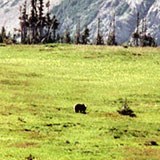 Grizzly bears dig extensively for bulbs of glacier lilies growing in alpine meadows and, in the process, control soil nitrogen dynamics and meadow plant assemblages, including the subsequent abundance and nutritive quality of the lilies. This is an original demonstration of large herbivore influences on terrestrial ecosystems.
Grizzly bears dig extensively for bulbs of glacier lilies growing in alpine meadows and, in the process, control soil nitrogen dynamics and meadow plant assemblages, including the subsequent abundance and nutritive quality of the lilies. This is an original demonstration of large herbivore influences on terrestrial ecosystems.
- Tardiff, S. E. and J. A. Stanford. 1998. Grizzly bear digging: effects on subalpine meadow plants in relation to mineral nitrogen availability. Ecology 79(7):2219–2228.
Kodiak Brown Bears and Salmon Abundance
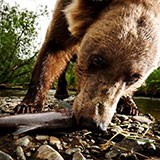 The FLBS Kodiak brown bear project is focused on understanding how bears of Southwest Kodiak Island, Alaska, behave in response to changing sockeye salmon abundance. The work, conducted by FLBS graduate student Will Deacy and other volunteers, is focused around Karluk Lake, the heart of the Kodiak National Wildlife Refuge. Although the refuge was established to protect Kodiak’s famous large bears and robust salmon runs, both bear and salmon numbers have been declining. U.S. Fish and Wildlife Service (FWS) data show that bear densities in the Karluk watershed have declined more than 45% in ten years, and this shocking population reduction created a need to better understand the relationship between salmon and bears. Plentiful salmon are critical to maintaining healthy populations of large Kodiak brown bears, so we have embarked upon a cooperative research program with the FWS using innovative field techniques to collect high resolution bear and salmon data across a suite of streams. To do this, we developed a process using remote time-lapse camera systems to count the number of salmon and bears at each of the streams around Karluk Lake.
The FLBS Kodiak brown bear project is focused on understanding how bears of Southwest Kodiak Island, Alaska, behave in response to changing sockeye salmon abundance. The work, conducted by FLBS graduate student Will Deacy and other volunteers, is focused around Karluk Lake, the heart of the Kodiak National Wildlife Refuge. Although the refuge was established to protect Kodiak’s famous large bears and robust salmon runs, both bear and salmon numbers have been declining. U.S. Fish and Wildlife Service (FWS) data show that bear densities in the Karluk watershed have declined more than 45% in ten years, and this shocking population reduction created a need to better understand the relationship between salmon and bears. Plentiful salmon are critical to maintaining healthy populations of large Kodiak brown bears, so we have embarked upon a cooperative research program with the FWS using innovative field techniques to collect high resolution bear and salmon data across a suite of streams. To do this, we developed a process using remote time-lapse camera systems to count the number of salmon and bears at each of the streams around Karluk Lake.
The Fish and Wildlife Service reached out to the Flathead Lake Biological Station (FLBS) to tackle this project because of our experience researching salmon ecosystems around the Pacific. Both the FWS and FLBS have made significant investments over the first three years of this project. We are now looking for partners to complete the final two years of the project and to collect the data needed to fully understand the impacts of salmon declines on Kodiak bears. While many bears still roam the Kodiak wilderness, long-term data suggests their numbers are declining in parallel with salmon abundance. It is critical that we understand the drivers of the salmon-bear relationship to protect this pristine landscape and the giants that roam it.
- Deacy, William, William Leacock, Jonathan B. Armstrong, and Jack A. Stanford. "Kodiak brown bears surf the salmon red wave: direct evidence from GPS collared individuals." Ecology 97, no. 5 (2016): 1091-1098.
Evolutionary Intricacy of Animal Behaviors
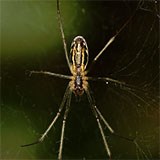 Long-term research on Sierra dome spiders that live on the Station grounds has demonstrated a novel evolutionary intricacy of animal behavior. Females choose a mate from a wide variety of male suitors that brawl with one another on the delicate dome-shaped webs built by the female. Mate choice by females determines the success or failure of the population.
Long-term research on Sierra dome spiders that live on the Station grounds has demonstrated a novel evolutionary intricacy of animal behavior. Females choose a mate from a wide variety of male suitors that brawl with one another on the delicate dome-shaped webs built by the female. Mate choice by females determines the success or failure of the population.
- Watson, P. J. 1995. Dancing in the Dome: males are lured by food and sex into erotic contests and deadly brawls. Natural History 104(3):40–43.

